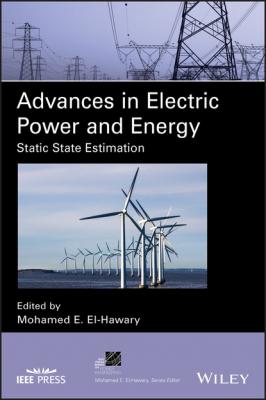Advances in Electric Power and Energy. Группа авторов
Читать онлайн.| Название | Advances in Electric Power and Energy |
|---|---|
| Автор произведения | Группа авторов |
| Жанр | Физика |
| Серия | |
| Издательство | Физика |
| Год выпуска | 0 |
| isbn | 9781119480440 |
2.5.10.1 Estimation Assessment
This subsection analyzes the performance of the estimators described in this chapter: WLS, LAV, QC, QL, LMS, LTS, and LMR.
To compare the accuracy provided by each estimator with regard to the true values for each scenario ω, the metrics
(2.47)
where
2.5.11 Results
The estimation problems previously mentioned are solved by using optimization software and by considering that parameters M and T are set to 100 and 2, respectively. The maximum number of iterations and the duality gap for MINLP problems is set to 1000 and 1%, respectively.
In order to remove mathematical unfeasibilities, the solutions to LMS and LTS mathematical problems are obtained by imposing that the set of measurements whose residuals are smaller than ∣yν( x )∣ provides whole system observability. This observability is achieved by forcing some binary variables to be equal 1 (i.e. bi = 1). These fixed variables correspond to a set of voltage and active power flow measurements that make the system observable.
Both numerical accuracy and computation performance are analyzed and compared. Tables 2.14 and 2.15 and Figures 2.13–2.15 provide results regarding estimation accuracy and computational performance:
Table 2.14 provides the mean and standard deviation of metrics and for each estimator considered.
Table 2.15 provides the minimum, mean, maximum, and standard deviation for the CPU time required (measured in seconds) for each estimator.
Figure 2.13 depicts the histogram of voltage magnitude absolute error for each estimator considered.
Figure 2.14 likewise shows the histogram of voltage angle estimation accuracy (measured in terms of absolute error ) for each estimation technique.
Finally, Figure 2.15 provides the histogram of the CPU time required (measured in seconds) for each estimation procedure.
TABLE 2.14 Case study: estimation accuracy results.
| Method |
|
|
|
|
|---|---|---|---|---|
| WLS | 0.0015 | 0.0012 | 0.0019 | 0.0015 |
| LAV | 0.0019 | 0.0015 | 0.0023 | 0.0018 |
| QC | 0.0017 | 0.0013 | 0.0020 | 0.0016 |
| QL | 0.0016 | 0.0012 | 0.0019 | 0.0015 |
| LMS | 0.0095 | 0.0083 | 0.0052 | 0.0043 |
| LTS | 0.0053 | 0.0052 | 0.0029 | 0.0024 |
| LMR | 0.0015 | 0.0012 | 0.0019 | 0.0015 |
TABLE 2.15 Case study: computational performance results.
| Method | Minimum (s) | Mean (s) | Maximum (s) | Std. dev. (s) |
|---|---|---|---|---|
| WLS | 0.84 | 0.96 | 1.37 | 0.09 |
| LAV | 0.37 | 0.56 | 0.76 | 0.07 |
| QC | 0.17 | 0.24 | 0.37 | 0.04 |
| QL |
|
